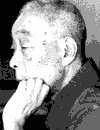- Kiyokata Kaburagi
Infobox Artist
name = Kiyokata Kaburagi

imagesize = 180px
caption = Kiyokata Kaburagi
birthname = Kaburagi Kenichi
birthdate =31 August 1878
location =Tokyo ,Japan
deathdate =2 March 1972
deathplace =Kamakura, Kanagawa ,Japan
nationality = Japanese
field = Painter
training =
movement =Nihonga ,Bijinga
works =
patrons =
awards =Order of Culture nihongo|Kiyokata Kaburagi|鏑木清方|Kaburagi Kiyokata (
31 August 1878 –2 March 1972 ) was the pseudonym of aNihonga artist and the leading master of thebijinga genre in Taishō andShowa period Japan . His real name was Kaburagi Kenichi. Incidentally, although his name is universally transliterated as "Kaburagi" by western sources (and many Japanese sources), Kaburagi himself used the pronunciation "Kaburaki".Early life
Kaburagi was born in
Kanda district ofTokyo to an affluent and literate family. His father was the founder and president of the "Tokyo Nichi Nichi Shimbun " newspaper, and a writer of popular novels. In 1891, young Kaburagi was sent to become a disciple ofukiyo-e artistsMizuno Toshikata andTaiso Yoshitoshi when he was 13 years old. His first job was as an illustrator for "Yamato Shinbun ," a Tokyo newspaper founded by his father. When he was sixteen, his father went bankrupt and the family had to sell their home.Artistic career
Kaburagi initially made his living as an
illustrator , producing frontispieces called "kuchi-e ", illustrating the titles of popularnovel s. His works were highly praised by noted authorIzumi Kyoka , who insisted that his novels be illustrated by Kaburagi. However, Kaburagi's first and foremost interest was in painting. In 1901, he helped create the nihongo|"Ugokai"|烏合会, an art group dedicated to reviving and popularizing the "bijin-ga " (images of beautiful women) genre. When the government-sponsored "Bunten " exhibitions were started in 1907, Kaburagi began to paint full time, winning several prizes.In 1915, his work "Murasame" won first prize at the 9th "Bunten" Exhibition.
In 1917, together with
Hirafuku Hyakusui ,Matsuoka Eikyu ,Kikkawa Reika andYuki Somei , he helped found the "Kinreisha", a "Nihonga" association training promising young artists, includingKawase Hasui .WhenWatanabe Shozaburo started an export woodcut print business, he needed many talented artists to make print designs appealing to western audiences. Kaburagi's group became a recruiting center for Watanabe. Kaburagi organized exhibitions with works of his students and introduced his best students to Watanabe. Next to Watanabe himself, it was probably Kiyokata Kaburagi, who had the greatest influence on the development and promotion of the "shin hanga " movement. Not only Kawase Hasui, but alsoIto Shinsui ,Shiro Kasamasu ,Yamakawa Shuho ,Torii Kotondo andTerashima Shimei were trained by Kaburagi and then introduced to Watanabe.When Kaburagi had reached his late 40s, he was well-established and a high respected artist. In 1929 he became a member of the
Imperial Fine Art Academy ("Teikoku Bijutsuin"). His portrait of "rakugo " actorSanyutei Encho (1930) has been registered as anImportant Cultural Property (ICP) by theAgency for Cultural Affairs . In 1938 he was appointed to the Art Committee of the Imperial Household. He received the official position ofcourt painter in 1944. In 1946, he was asked to be one of the judges for the first post-war "Nitten " Exhibition. In 1954, he received theOrder of Culture .His house in Tokyo was burned down during the firebombing of Tokyo in
World War II , and he relocated to Kamakura,Kanagawa prefecture , where he lived until his death.Kiyokata Kaburagi died in 1973 at the age of 96. His grave is at the
Yanaka Cemetery in Tokyo. His house has been transformed into the Kaburagi Kiyokata Memorial Museum, displaying many of his works, and preserving his studio.Philately
Two of Kaburagi's works have been selected as the subject of a
commemorative postage stamp s by the Japanese government:
* 1971: "Tsukiji Akashimachi" (1927), for the 1971 Philatelic Week
* 1980: "Ichiba" (1940), as part of the Modern Art seriesExternal links
* [http://www.kamakura-arts.or.jp/kaburaki/index.html Kaburagi Kiyokata Memorial Museum (Japanese site)]
* [http://www.adachi-museum.or.jp/e/c_kiyokata.html biography and sample from Adachi Museum]References
* Conant, Ellen P., Rimer, J. Thomas, Owyoung, Stephen. "Nihonga: Transcending the Past: Japanese-Style Painting, 1868-1968". Weatherhill (1996). ISBN 0834803631
* Kimura, Ihee. "Four Japanese painters: Taikan Yokoyama, Gyokudo Kawai, Shoen Uemura, Kiyokata Kaburaki" (JPS picture books). Japan Photo Service (1939). ASIN: B000888WYA
* Shiokawa, Kyoko. "Shisei no bunjin Kaburagi Kiyokata". Dai Nihon Kaiga (1991). ISBN-10: 4499200997
Wikimedia Foundation. 2010.
